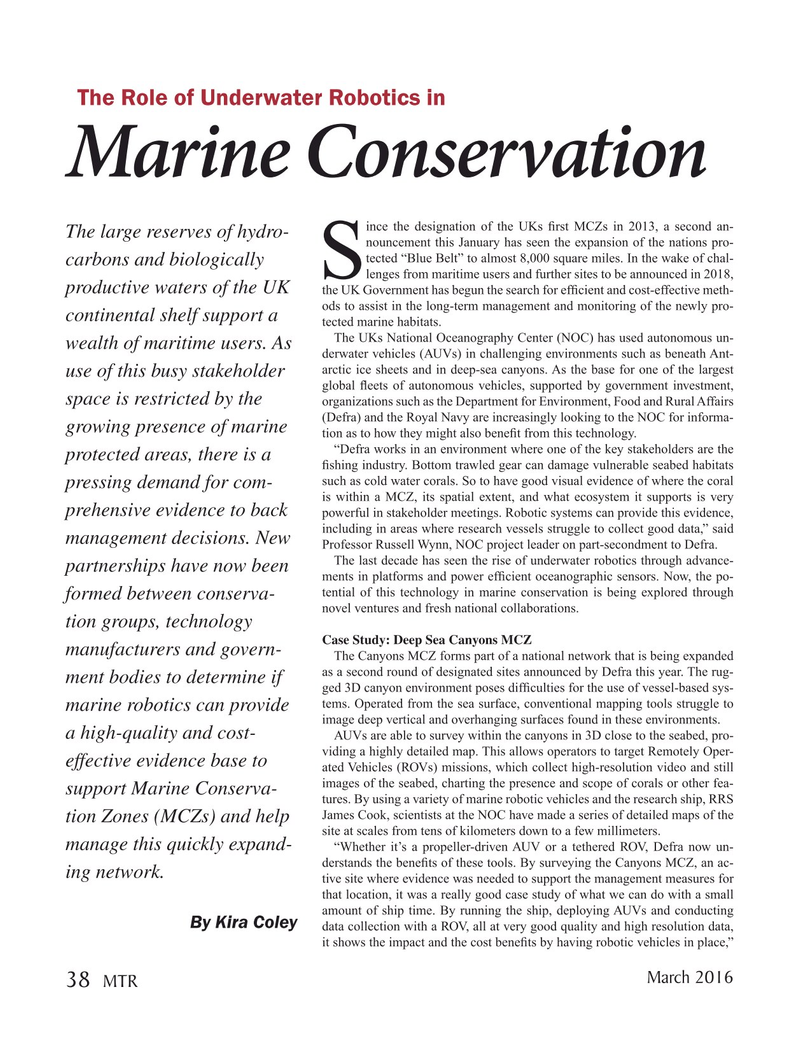
Page 38: of Marine Technology Magazine (March 2016)
Oceanographic Instrumentation: Measurement, Process & Analysis
Read this page in Pdf, Flash or Html5 edition of March 2016 Marine Technology Magazine
The Role of Underwater Robotics in
Marine Conservation ince the designation of the UKs ? rst MCZs in 2013, a second an-
The large reserves of hydro- nouncement this January has seen the expansion of the nations pro- tected “Blue Belt” to almost 8,000 square miles. In the wake of chal- carbons and biologically
Slenges from maritime users and further sites to be announced in 2018, productive waters of the UK the UK Government has begun the search for ef? cient and cost-effective meth- ods to assist in the long-term management and monitoring of the newly pro- continental shelf support a tected marine habitats.
The UKs National Oceanography Center (NOC) has used autonomous un- wealth of maritime users. As derwater vehicles (AUVs) in challenging environments such as beneath Ant- arctic ice sheets and in deep-sea canyons. As the base for one of the largest use of this busy stakeholder global ? eets of autonomous vehicles, supported by government investment, space is restricted by the organizations such as the Department for Environment, Food and Rural Affairs (Defra) and the Royal Navy are increasingly looking to the NOC for informa- growing presence of marine tion as to how they might also bene? t from this technology.
“Defra works in an environment where one of the key stakeholders are the protected areas, there is a ? shing industry. Bottom trawled gear can damage vulnerable seabed habitats such as cold water corals. So to have good visual evidence of where the coral pressing demand for com- is within a MCZ, its spatial extent, and what ecosystem it supports is very prehensive evidence to back powerful in stakeholder meetings. Robotic systems can provide this evidence, including in areas where research vessels struggle to collect good data,” said management decisions. New
Professor Russell Wynn, NOC project leader on part-secondment to Defra.
The last decade has seen the rise of underwater robotics through advance- partnerships have now been ments in platforms and power ef? cient oceanographic sensors. Now, the po- tential of this technology in marine conservation is being explored through formed between conserva- novel ventures and fresh national collaborations.
tion groups, technology
Case Study: Deep Sea Canyons MCZ manufacturers and govern-
The Canyons MCZ forms part of a national network that is being expanded as a second round of designated sites announced by Defra this year. The rug- ment bodies to determine if ged 3D canyon environment poses dif? culties for the use of vessel-based sys- tems. Operated from the sea surface, conventional mapping tools struggle to marine robotics can provide image deep vertical and overhanging surfaces found in these environments. a high-quality and cost-
AUVs are able to survey within the canyons in 3D close to the seabed, pro- viding a highly detailed map. This allows operators to target Remotely Oper- effective evidence base to ated Vehicles (ROVs) missions, which collect high-resolution video and still images of the seabed, charting the presence and scope of corals or other fea- support Marine Conserva- tures. By using a variety of marine robotic vehicles and the research ship, RRS
James Cook, scientists at the NOC have made a series of detailed maps of the tion Zones (MCZs) and help site at scales from tens of kilometers down to a few millimeters.
manage this quickly expand- “Whether it’s a propeller-driven AUV or a tethered ROV, Defra now un- derstands the bene? ts of these tools. By surveying the Canyons MCZ, an ac- ing network.
tive site where evidence was needed to support the management measures for that location, it was a really good case study of what we can do with a small amount of ship time. By running the ship, deploying AUVs and conducting
By Kira Coley data collection with a ROV, all at very good quality and high resolution data, it shows the impact and the cost bene? ts by having robotic vehicles in place,”
March 2016 38
MTR
MTR #2 (34-49).indd 38 2/19/2016 11:48:09 AM

 37
37

 39
39
